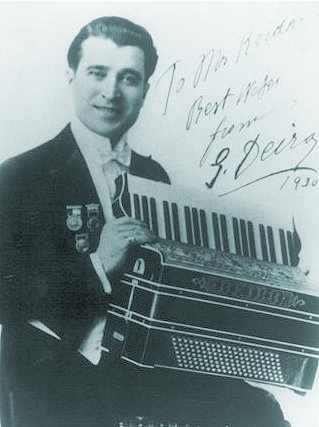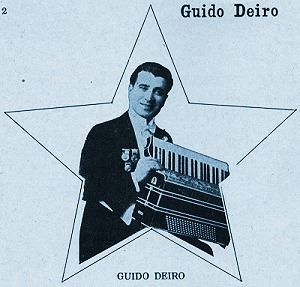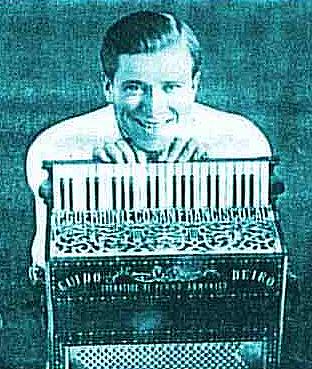 |
Guido Deiro
This master of the Piano Accordion was born in Salto Canavese near Turin in Piedmont, Italy, and started to play the accordion when nine years old, being the first of his family to play this instrument.
This was against the wishes of his father who wanted to make a grocer out of the small Guido. But in his own words, "with music singing in my heart there was no inspiration in potatoes and beans," and by the time Guido was 14 [according to one report] he was in Switzerland, playing professionally on the accordion and was already making a name for himself as a virtuoso of this instrument.
His work took him to Germany and it was there he first became acquainted with what is now known as the piano accordion and resolved to possess one as soon as possible.
Returning to Italy in 1906 to serve in the army, he was assigned to the band of the 29th infantry, playing several wind instruments but featuring the bass. The attractiveness of the new instrument heard in Germany was no forgotten and one was built to order for his use. Additional fame came with the skillful use of this resourceful instrument, and in 1908 the innate ambition and restlessness of the true musician asserted itself and Deiro came to America, landing in Seattle. The success which had attended the use of this new instrument, his own confidence in its musical worth, and the skill which he had acquired in its use led Deiro to put to the test an idea of his own that had long been forming, the idea that this instrument was good enough to hold its own in any company and with any kind of music -- elevating it to a concert instrument of the first rank. Previous to this time it had not had this distinction, being considered an instrument for street playing and similar uses only.
In 1910, Deiro was booked on the bill at the American Theatre in San Francisco, as the Premier Piano Accordionist -- a designation that could not be more correct, for up to this time the instrument had not been used on the stage. Deiro, at this time, also furnished the name by which the instrument is since known, -- translating its Italian name of "Armonica Sistema Piano" to "Piano Accordion." As the crucial moment approached when his confidence was to be put to the test, we can well imagine the anxiety of this Italian musician. Would he be a flop, and the new Piano Accordion prove unable to hold its own?. Financially and artistically, it was a critical time for Deiro. In his own words, as he told it to us: "I stepped into the spot-light, I and my piano accordion, right into the glare of it. There was the time and the place to show what could be done with this instrument. It's now or never, I told myself, and began to play. I forgot about my fingers and the keys of wood and celluloid. I only remembered that my heart was full of melody and I wanted to show the people in the theatre how beautiful that melody was."
The Premier was a huge success, and Deiro and his accordion were established musically in this country from that time on. But to Deiro must go the credit of proving the piano accordion a stage and concert instrument of first rank, and of starting the movement in it which has grown to such great proportions. Many concert and stage engagements came after the American theatre debut. Deiro has since appeared over the radio, in the talking pictures, made records, and also was the first to introduce the instrument in these fields. He had composed many admirable numbers for the instrument, numbers played by all accordion players. He is responsible for the addition of the augmented 5th chord to the basses, an addition which greatly increased the resourcefulness of the instrument. It is evident that even as brief a sketch as this is, of the life and work of Guido Deiro, is also a history of the rise and acceptance of the piano accordion as one of the greatest of modern instruments. For they are both the same thing.
-- The Publishers --

Above text from Guido Deiro's Royal Method for Piano Accordion: A Comprehensive Course of Modern Instruction for the Accordion, volume I, page 2. Copyright 1936 by Mills Music, Inc. 1619 Broadway, New York 19, N.Y.
 Guido Pietro Deiro was born in the village of Salto Canavese (See End Note 1), Italy on September 1, 1886. He was a famous vaudeville star, international recording artist, composer and teacher. He was the first accordionist to play big-time vaudeville. (See End Note 2)
Guido Pietro Deiro was born in the village of Salto Canavese (See End Note 1), Italy on September 1, 1886. He was a famous vaudeville star, international recording artist, composer and teacher. He was the first accordionist to play big-time vaudeville. (See End Note 2)
Guido and his younger brother Pietro were among the highest paid performers on the circuit. He started teaching when the "talkies" [movies with sound] forced many vaudeville shows to close. He taught with Louis Allara at Green and Columbus Avenues in San Francisco. Guido Deiro was quite a man with the ladies and married four beautiful women; his second marriage was with the famous film star, Mae West.
This great pioneer of the accordion, a man loved by all, passed away on July 26, 1950. A year earlier, he had a nervous breakdown due to overwork and exhaustion. A month before his death, a Guido Deiro benefit concert was held in Los Angeles. Among the entertainers at this event were Anthony Galla-Rini, the Ernie Felice Quartet, Johnny Kiado and the Tito Quartet, to name just a few. Fourteen-year-old Dolly Bowers, a Guido Deiro prot g , received encore after encore. She played Guido's latest and what was to be his last composition, The Queen of the Air (March).
During his last days, Guido had his three best friends with him: Syl Prior, James Haney and Anthony Galla-Rini. A fitting tribute was paid to this superb artist by Sydney Dawson of the Accordion Teachers' Guild: "Guido died a great man. His greatness was felt when he walked into any group."
End Note 1:
Explanation by Guido Deiro's son, Count Guido Roberto Deiro
My cousins maintain and still reside in a nearly 300 year old home in Salto. Adjacent is small Catholic church dedicated to the Nativity of Mary and built by my ancestors that has been in daily use since 1710. The remains of the family fortified great house (castle) have also been modernized and it is now the home of several families. The Deiros are a prosperous and prolific clan engaged in retailing through the ownership of general stores in surrounding communities. My grandfather, Count Carlo Pietro Deiro (1863-1937), is entombed in the nave of the Church of San Giacomo in Salto.
Guido and Pietro were the only issue of my grandfather. He had three sisters and two brothers.
There are several modern family lines carrying the Deiro surname. Not all are related to my ancestral line sired by the brothers Antonio (1586-1620) and Giacomo (1588-1620). Both died of plague. It is oral history, backed by the existence of the village of San Miguel de Deiro in Galicia, Spain, that the Deiro clan were Galicians who took part in an expansion into the Italian Piedmonte most probably during the middle 1500's. A pledge of fealty to the French crown in the late 1600's, accompanied by the satisfaction of a levy of men and arms to the house of Savoy, resulted in the present family entitlement as "Counts of Canavese and Solasco" although they were already ennobled as the "Lords of Arya" in Spain.
The name "Deiro," which interestingly hasn't been corrupted all these centuries, is notoriously abused, both in spelling and pronunciation, which dogged my poor father throughout his career and myself in the misspelling of the street here in Las Vegas. As close as I can make it in English, phonetically it is pronounced "Dayrow," Italians rolling the "r".
Both Guido and Pietro are well remembered and admired. Guido never returned to Italy. There was bad blood with his father. It was that dispute that led to his leaving home. My Uncle did visit once around 1930 probably for the distribution of my grandfather's estate. What was once a significant holding of land was lost at the conclusion of W.W.II under the Communist controlled redistribution of land and the abandonment of the monarchy. Italy became a Republic in 1947 and the King crossed the mountains into exile in Switzerland.
My entire family are Roman Catholics and have been for as far back as the church written records go. At least the fifteenth century. The Deiro's built a church nearly four hundred years ago that is still in daily use. I have prayed in it. But, they were also Muslims in Spain, and in the Sudan, and before that they were Syriac Orthodox Christians. The name is Syriac...one of the languages spoken by Christ. Deiro means the same thing in Syriac, Arabic, Galician Spanish, and Italian. 'Point of...' such as 'Deiro Nero' ...black point....usually it defines a point of note like a promontory. In Syria, Orthodox monks, and the monastery they reside in, are referred to as 'Deiros.'
End Note 2:
Vaudeville was light entertainment popular in the United States from the mid-1890s until the early 1930s, consisted of ten to fifteen individual unrelated acts, featuring magicians, acrobats, comedians, trained animals, jugglers, singers, musicians and dancers.
Above text from: Ronald Flynn, Edwin Davison, Edward Chavez, The Golden Age of the Accordion (Schertz, Texas, Flynn Publications: 1992), 6.
Very few people know that my father's middle name was Pietro. Guido's birthplace was the village of Salto Canavese. This village is located in the fraction (county) of Deiro. There is actually an "Upper" and "Lower" Deiro. They lie at the foot of the Gran Paradisio di Alpi a popular alpine park similar to our Yosemite approximately 30 miles west of Torino.
Back
Next